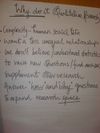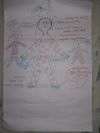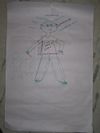What is good qualitative research?
Warning: Display title "What is good qualitative research?" overrides earlier display title "Qualitative_research".
What is good qualitative research?
Time: 45-60 minutes
Objectives:
- To develop an appreciation of what makes a piece of qualitative research “good” qualitative research, by taking participants through a series of exercises in which they think through what is involved.
Preparation:
- Flip chart and big markers (OR use someone sitting at a computer and typing in points raised so that they are shown on a projector screen)
Process:
Introduce this as a brainstorm, not a didactic session. Participants need to have their understandings stretched beyond the ‘text-book’ answers to questions like:
- What is qualitative social research?
- What makes it different from quantitative research?
- What are the main methods of qualitative research?
- Why might we want to use them?
Some examples of points raised by participants in some of our previous training sessions can be seen in the images below as well as the powerpoint on Good Qualitative Research - examples from workshop feedback ![]() .
.
After the group brainstorm it will be useful to go through some of the points that have been highlighted in the power point Introduction to qualitative research ![]() . Use this as an opportunity to clarify any doubts and build on the knowledge of the participants.
. Use this as an opportunity to clarify any doubts and build on the knowledge of the participants.
What are the characteristics of a good qualitative researcher?
Time: 45-60 minutes
Objectives:
- To help participants appreciate the central role of the researcher in a qualitative study
- To establish the researcher as the main instrument in the research process
Preparation:
- Big sheet of paper/ chart paper for each small group with a human figure (gender neutral) drawn on it
Process:
Ask participants to arrange themselves in smaller groups (of 3-4) and give each group a chart paper with an outline of a human figure (gender neutral). Ask participants to work in their small groups and make this figure into a ‘researcher’ – they can use words, symbols and anything else they might wish to use to develop their image of a good qualitative researcher. Participants will spend 15 minutes on the task.
Each group is then required to present their image of a good qualitative researcher to the whole group. Allow time for questions and discussions.
Additionally, you might like to draw on and review the images and presentation of examples from our workshops on the characteristics of a good qualitative researcher ![]() that have been provided. Propose these to the participants and discuss their relevance (or even perceived irrelevance).
that have been provided. Propose these to the participants and discuss their relevance (or even perceived irrelevance).
What is reflexivity?
Time: 45-60 minutes
Objectives:
- By the end of the session participants should understand the importance of reflexivity; of the researcher as the main research instrument in qualitative research; and of the research diary as a reflexive tool
Preparation:
- Flip chart and big markers (OR use someone sitting at a computer and typing in points raised so that they are shown on a projector)
Process:
Ask participants to brainstorm in small groups and report back on the following questions:
- What do we mean by reflexivity?
- Why is reflexivity important?
- How do we achieve it?
- How are reflexivity and ethics related in research?
Some of these points may have been raised in the previous session: facilitators should choose whether to deal with them in the earlier session or come back and give them more time in this session.
To wrap up the discussion you can circulate the handout on reflexivity ![]() .
.
Here is a sample list of some of the issues that participants should be discussing:
Reflexivity
- Things we “take for granted” need to be challenged and made explicit
- Regularly/ evolving
- Change through time
- Reflect on method
Ethics
- Is there consent from participants?
- Contradictions between interview and behaviour; also between interview and general talk
- Reliability of the research
- Confidentiality and trust
- Anonymity
- Security of data
- Reporting illegal/ abusive behaviour
Sampling in qualitative research
Time: About 1 hour
Objectives:
- By the end of the session participants should understand how strategic sampling and in-depth data makes qualitative research useful either for extending social science or for contributing to policy discussions
Preparation:
- A Presentation on Sampling
 is available to be used or amended if desired
is available to be used or amended if desired - An article by Bent Flyvbjerg was used in preparing the handout, and the presentation is available at (http://flyvbjerg.plan.aau.dk/Publications2006/0604FIVEMISPUBL2006.pdf). It makes a strong case for the contributions of case studies to social science. Depending on the participants, consider getting them to read this, either before or after the session.
- A Handout on Sampling in Qualitative Research
 can also be distributed to participants.
can also be distributed to participants. - Flip chart and big markers (OR use someone sitting at a computer and typing in points raised so that they are shown on a projector)
Process:
This session is likely to be didactic in nature and you can draw on the power point to begin the discussions. You will need to allow the session to develop slowly so that you can explain things clearly. It is important that participants understand that certain generalisations can be made based on small samples and qualitative research.
At the end of the session distribute the hand outs and ask participants to review them. This can be a difficult session and hence you need to be slow in your pace. Give time to participants for reading, discussing and consolidating their understandings.
Further Reading
Tuhiwai-Smith, L. (1999) Decolonizing Methodologies: Research and Indigenous Peoples, London: Zed Books
![]() Singal, N., and Jeffery, R. (2008). Qualitative Research Skills Workshop: A Facilitator's Reference Manual, http://oer.educ.cam.ac.uk/wiki/RECOUP, Cambridge: RECOUP (Research Consortium on Educational Outcomes and Poverty, http://recoup.educ.cam.ac.uk/). CC BY-NC-SA 4.0. (original page)
Singal, N., and Jeffery, R. (2008). Qualitative Research Skills Workshop: A Facilitator's Reference Manual, http://oer.educ.cam.ac.uk/wiki/RECOUP, Cambridge: RECOUP (Research Consortium on Educational Outcomes and Poverty, http://recoup.educ.cam.ac.uk/). CC BY-NC-SA 4.0. (original page)












